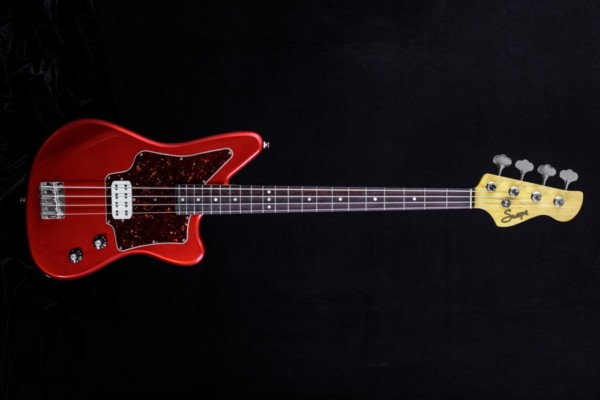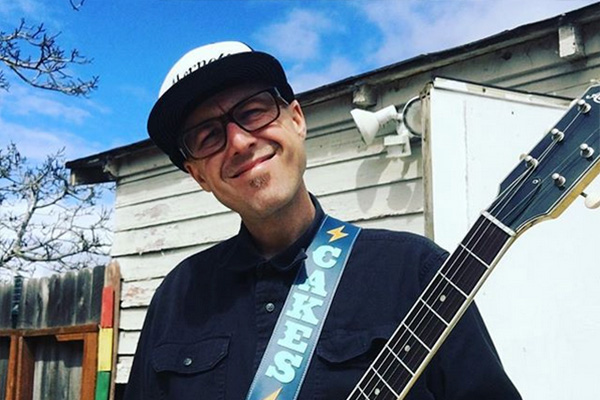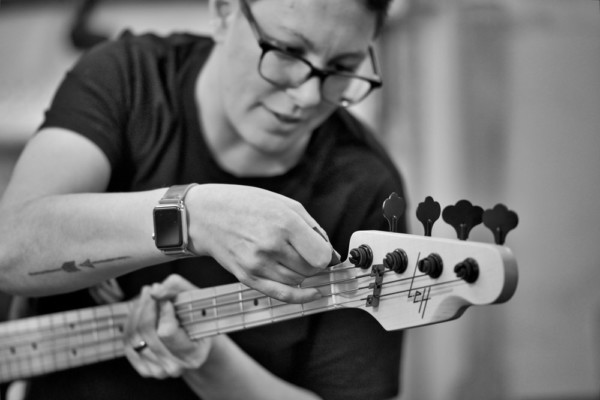Custom Shop: Curtis Novak
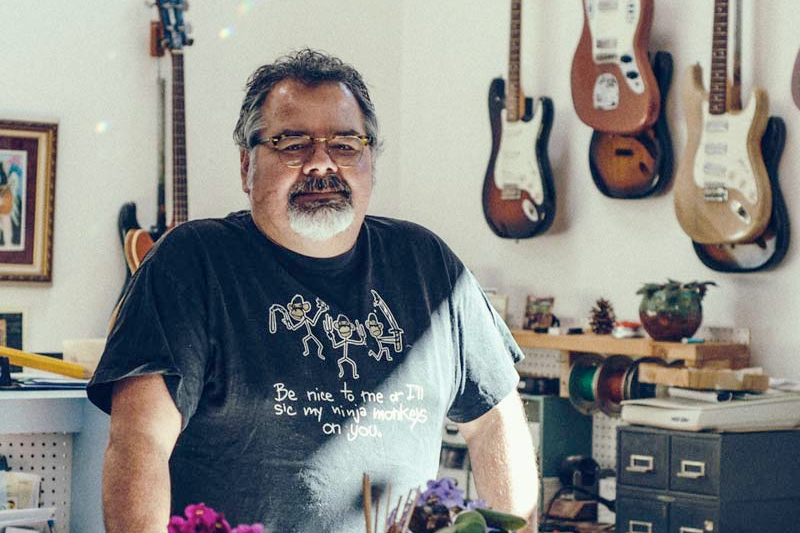
In the crowded world of aftermarket pickup makers, few continue to explore with as much passion and childlike wonder as Curtis Novak. Whether he is reimagining a classic pickup design or forging something new altogether, Curtis keeps the quest for a perfect tone at the forefront of his mind.
Curtis grew up in New Mexico, the youngest of five. He got his hands on an acoustic guitar as a kid but soon became frustrated, as it had no moving parts or electronics to tinker with. Soon after, he received his first electric guitar, but he was still unsatisfied; it just didn’t sound right. He zealously began to rally his parents to get him a set of Seymour Duncan replacement pickups. “I would slip ads in my dad’s magazines or bring it up at dinner when it wasn’t appropriate,” he recalls. He eventually got the pickups and installed them straight away. After hearing the magnificent sound of the newly equipped guitar, Curtis experienced a revelation: he realized just how much of an effect pickups could have on the tone of an instrument.
Newly armed with that knowledge, Curtis began a life-long quest to explore the endless possibilities of tone. He would often cold-call the Fender factory to pick the brains of the pickup winders, and he even befriended Seymour Duncan himself, one of the pioneers of the aftermarket pickup industry.
Like many pickup makers, he first mastered the standards, such as the Fender and Gibson pickup varieties. All the while, he held down a government job (with high-level security clearance) in computer science. He had always shown a healthy aptitude for working with computers and was involved in the earliest developmental days of the World Wide Web. In fact, he remembers having created one of the first real estate search engines in existence, certainly ahead of its time!
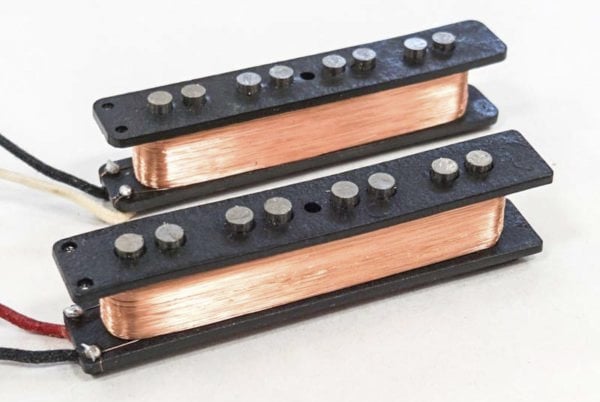
Curtis kept his pickup-making business humming along on the sidelines until eventually, in his early forties, he realized that his day job no longer felt fulfilling and that his pickups were fetching enough money to sustain his standard of living. So he quit his job and moved to North Carolina to devote all of his time to Curtis Novak Pickups.
Talking to Curtis, two things are readily apparent: he values a peaceful, laid-back lifestyle, and he loves researching and developing new ideas. Quitting his day job to focus on making pickups would further both of those ideals. Having already achieved a healthy momentum selling popular aftermarket pickups, he was eager to explore more obscure designs. He recalls his Fender Electric XII replacement pickup as being one of the first projects he took on with the new business. Many other experiments were soon to follow as Curtis was finally able to take full charge of his obsession with discovering new ways of breathing life into old pickups.
 The bass pickup Curtis is best known for lately is the BS-DS, his take on the revered Hagstrom Bi-Sonic. The Bi-Sonic, found in many Hagstrom and Guild basses of the ’60s and ’70s, is characteristic for its thick, dark sound and uniquely voiced midrange, and for being encased in a shiny black plastic cover with a nickel-plated bezel. It is a truly striking piece of gear! In the 2000s, a pickup maker named Fred Hammon was the first to recreate this rare pickup. He called it the “Darkstar,” a nod to the Grateful Dead whose bassist, Phil Lesh, played a huge role in popularizing the original Bi-Sonic. However, Hammon’s pickup did not emulate the tone of the Bi-Sonic perfectly. Its sound was more modern and aggressive, with increased treble and midrange frequencies.
The bass pickup Curtis is best known for lately is the BS-DS, his take on the revered Hagstrom Bi-Sonic. The Bi-Sonic, found in many Hagstrom and Guild basses of the ’60s and ’70s, is characteristic for its thick, dark sound and uniquely voiced midrange, and for being encased in a shiny black plastic cover with a nickel-plated bezel. It is a truly striking piece of gear! In the 2000s, a pickup maker named Fred Hammon was the first to recreate this rare pickup. He called it the “Darkstar,” a nod to the Grateful Dead whose bassist, Phil Lesh, played a huge role in popularizing the original Bi-Sonic. However, Hammon’s pickup did not emulate the tone of the Bi-Sonic perfectly. Its sound was more modern and aggressive, with increased treble and midrange frequencies.
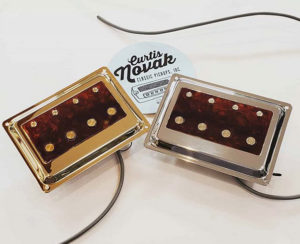 Believing that both pickups had their strengths, Curtis decided to incorporate qualities from each in his BS-DS pickup. Curtis says he prefers the Hagstrom Bi-Sonic sound, hence the “BS” portion of the pickup. But many customers were asking for the sound they heard from Hammon’s Darkstar — hence the “DS.” With a coil tap coming off the pickup, players can experience both the darker, fatter tone of the Bi-Sonic as well as the clearer, more present tone of the Darkstar.
Believing that both pickups had their strengths, Curtis decided to incorporate qualities from each in his BS-DS pickup. Curtis says he prefers the Hagstrom Bi-Sonic sound, hence the “BS” portion of the pickup. But many customers were asking for the sound they heard from Hammon’s Darkstar — hence the “DS.” With a coil tap coming off the pickup, players can experience both the darker, fatter tone of the Bi-Sonic as well as the clearer, more present tone of the Darkstar.
Perhaps it’s no coincidence that Curtis, the Bi-Sonic, and Phil Lesh share a common thread. In the early ’80s, Curtis excitedly attended a Grateful Dead concert in Santa Fe at which he stood near the stage wearing a large sombrero. He soon noticed complaints coming from neighboring fans: apparently, his voluminous headpiece was obscuring their view of the show. Being a kindhearted soul, Curtis removed the sombrero and frisbee’d it onto the stage as a sacrificial offering to the music gods. But that was not to be the last of the fated sombrero. After the next set break, Lesh traipsed back to his post on stage wearing it proudly!
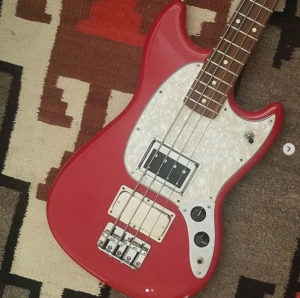
And the synchronicities continued. Many years later, Curtis would be called upon to make pickups for Oteil Burbridge, who had just taken on the role of bassist with none other than the Dead & Company, a band consisting of former Grateful Dead members playing the Dead’s music alongside other musicians. Oteil faced a dilemma: the band wanted him to cop the vintage-leaning tone that Phil Lesh was known for in the early days of the Grateful Dead, but Oteil much preferred playing his modernized Modulus basses. The solution: to have Curtis wind pickups for the Modulus basses that would sound familiar to the other musicians, while allowing Oteil the comforts of playing his preferred instruments.
Curtis speaks very fondly of working with musicians to explore tone. “I like to sit with somebody and see what they hear,” he says. Always interested in differing perspectives, he asks himself questions like, “What do other people like? What do they hear?” He is endlessly experimenting, and working with a variety of musicians provides him with very fertile ground to do so.
He relates pickups to camera lenses: there is a certain range of frequencies you can capture with a pickup and many different ways to capture those frequencies, but in the end, there is no one right way to go about it. He warns that commonly listed pickup specs can be misleading and can distort our perception: “People start listening with their eyes, not their ears.” He also likens a pickup to a paintbrush. Each artist uses a different brush and uses it uniquely. Curtis likes to disconnect from popular conceptions of what pickups are supposed to sound like. This allows him to venture into unexplored territories. “I’m taking science out of this,” he says. All this goes to show that despite having mastered his craft, Curtis keeps always keeps an open mind about tone.
It should be mentioned that Curtis has surrounded himself with an amazing team that includes his wife Sheri along with employees Brian McKinney, Dana Longuevan, and Jonathan Hischke. Curtis speaks of his team as more like a family, and he has created a very laid-back, low-stress work environment that takes into account everyone’s ambitions and personal time. Curtis is more interested in cultivating a healthy lifestyle for everyone rather than a strict corporate culture. Sheri and he will often start the day tending to their garden rather than jumping right into answering emails and paying bills.
The engine that drives the whole organization forward is Curtis’s relentless passion, quite possibly even need, for research and development and experimentation. As with any successful creator, his attempts end in failure from time to time. On the phone with me, Curtis, with a chuckle, describes his usual reaction to these near-misses-with-success: “I’ll never make another one of these, but now I know!” He continues to add to a decades-long adventure with a lively spirit and an even livelier team working beside him. I am left with one of Curtis’s casual remarks stuck in my mind: “What I like the most is the thing I haven’t figured out yet.” This mantra seems especially important in that, just as Curtis has turned a passion for the unknown into a way of life, we might all benefit from pushing our own boundaries a little further each day.
From his first time picking up a bass 16 years ago, to starting his own bass company, Serek Basses, in 2015, Jake Serek has been on a mission. Touring with bands such as Smashing Pumpkins, KISS, and Slash gave him a taste of the professional life. His experiences working at Lakland and Third Coast guitar repair sharpened his skills.
